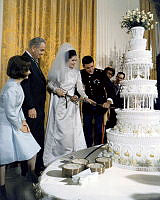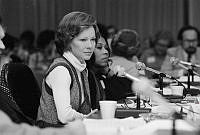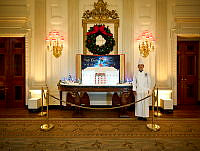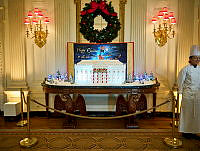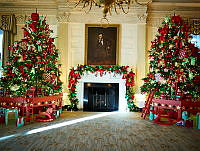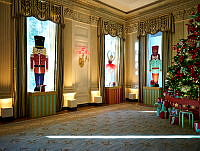Rubenstein Center Scholarship
American Fashions for American First Ladies: How Ellen and Edith Wilson’s Time in the White House Led to the Expectation for First Ladies to “Buy American”
In 2011, American fashion designer Oscar de la Renta criticized First Lady Michelle Obama for wearing a British label, Alexander McQueen, to a State Dinner for President Hu Jintao of China at the White House.1 Although Mrs. Obama was known for wearing American designers, including more affordable options such as J.Crew, this criticism attracted press attention and is the kind of critique that can linger throughout an administration. In the modern American mind, there is an expectation for the first lady of the United States to wear American designers to serve as an example to the public and support the American garment industry. However, this mindset regarding the role of the first lady in consumer trends, and the idea of consumption as a patriotic act, has not always been the case.
While many historians who study American consumerism argue that the “citizen consumer” emerged in the post-World War II era, there was a concerted effort in the 1910s to equate consumption with patriotism, and the first ladies of the Woodrow Wilson White House – Ellen Wilson and Edith Wilson – were key players in that shift.2 This change, more specifically, focused on fashion and the desire among American manufacturers to challenge Paris fashion houses’ dominance in the American imagination.

Woodrow Wilson at the Liberty Day parade, April 26, 1918.
National Archives and Records AdministrationMany Americans have looked to Paris for fashion inspiration since the early days of the Republic with both Thomas Jefferson and James Monroe bringing French influence to the furniture, china, and cuisine of the White House, setting a standard for an American aesthetic informed by French taste.3 First Lady Elizabeth Monroe (pictured below) brought French fashion to the White House after her time living in France, and attending the court of Napoleon.4 She was inspired by the elaborate court costumes, that included distinctive puffed sleeves and sumptuous, imported textiles.5 By the mid-nineteenth century, the first major fashions houses had emerged in Paris, making it the world’s fashion capital.6

Reproduction of a painting attributed to John Vanderlyn. Elizabeth Monroe is painted in the puffed sleeves and ermine that were popular in the Napoleonic court.
White House Collection/White House Historical AssociationAmericans of the late nineteenth century looked to Parisian designers as the arbiters of taste and style.7 Some residents of the White House, including First Lady Frances Cleveland, were especially interested in Parisian fashion.8 There were some, however, such as First Lady Caroline Harrison, who stood in vocal opposition to imported fashion by wearing gowns designed and manufactured in America.9 The Harrisons’ support of American manufacturing was not popular enough to keep them in the White House for a second term, and they were replaced by Grover and Frances Cleveland who brought her French wardrobe back to Washington. Frances Cleveland’s youthful and fashionable image was far more appealing to the public than Caroline Harrison’s traditional values. Prominent American socialites from Washington traveled to Paris every year to purchase their wardrobe for the season and their purchases were anxiously reported to middle-class Americans.10 As the twentieth century dawned, increased access to fashion magazines made it easier for American women to keep up with the rapidly changing trends of the industry.

Frances Folsom Cleveland in her wedding dress, June 2, 1886.
Library of CongressAt the same time, the American garment industry grew at an unprecedented speed. Demand for military uniforms during the Civil War jumpstarted the American ready-to-wear industry, which soon provided relatively cheap and accessible clothing to the American public.11 With their increased power, American manufacturers began to view the chokehold that Paris had on Americans as a roadblock to their success.
It was into this environment that First Lady Ellen Wilson moved her family into the White House in March 1913. As the wife of a career academic and former governor of New Jersey, Ellen Wilson was familiar with frugality and found herself unprepared for the fashionable Washington social scene.12 The journalists covering the Wilsons’ preparations to move into the White House were shocked to find that Ellen Wilson only spent $1,000 on her White House wardrobe.13 One newspaper reported that “dressmakers” said that it was “impossible for Mrs. Woodrow Wilson to provide a suitable wardrobe for the ‘first lady of the land’” at such a small budget. An article from March 1913 discusses the possibility that Mrs. Wilson’s tenure in the White House could bring about the rise in popularity of “simple gowns,” highlighting the implied power that any first lady might have in influencing the purchasing decisions of the American public.14 Coverage of Mrs. Wilson’s Inauguration outfit posited the possibility of the first lady setting “a fashion in coats that is apt to be followed by smart women all over the country.15 Although the coverage admits that her skirt was “almost plain,” her style was lauded as being “distinctly American,” bringing up the issue of what precisely makes up an American fashion aesthetic. Ellen Wilson’s daughters were equally if not more popular in news coverage. Their tastes were, similarly, described as “simple” by reporters with coverage predicting that fashions inspired by the young Wilsons would turn away from “artificial and elaborate” styles."16

Ellen Wilson posed at the White House wearing a simple, conservative dress, June 9, 1913.
Library of CongressAmerican manufacturers were aware of the first lady’s power to influence the spending habits of American women. As the Wilsons entered the White House, their close friend Edward E. Bok, the editor of popular magazine The Ladies’ Home Journal, began a campaign of “fashion nationalism” seeking to convince American women to abandon Paris in favor of American fashions.17 American women, however, would not be easily swayed as they experienced what historian Kristin Hoganson calls “imagined communities of dress,” inspired by Benedict Anderson’s term “imagined community,” used to describe the modern nationalist experience of a sense of belonging and understanding among people who had never met.18 Hoganson argued that American women felt a similar sense of belonging to an imagined international community centered around fashion that transcended a sense of an American identity.19 The sense of a “transnational aesthetic” worried American manufacturers who were interested in creating a distinctly American aesthetic to accompany burgeoning nationalist ideology.20
In April 1913, Edward Bok enlisted the help of family friend and newly minted First Lady Ellen Wilson. In the April edition of the Ladies’ Home Journal, Ellen Wilson appears twice, promoting Bok’s agenda towards “American Fashions for American Women.” First, a column on page 7 notes: “The willingness of Mrs. Woodrow Wilson and her daughters to declare… their belief in favor of American-designed fashions for American women”.21 The column explicitly ties Mrs. Wilson to the campaign by The Ladies’ Home Journal. Later in the same issue, a two-page spread more specifically highlights the Wilsons’ support for “American Fashion” in practice. The spread features dresses by American designers “personally selected” by Ellen Wilson and her three daughters Eleanor, Jessie, and Margaret.22 Although the gowns feature the revived empire waist, moving away from the heavily corseted look of the turn of the century, the high necklines and structured collars promote a conservatism that placed American fashion in opposition to European excess.

Wilson-Sayre Wedding Party, December 6, 1913. Jessie Wilson is seated in the middle, front row, wearing her American-made wedding dress. Behind her are her groom, Francis Sayre, and her parents President Woodrow Wilson and First Lady Ellen Wilson.
Library of CongressThe media continued crafting a patriotic image of the Wilson daughters with an article describing Margaret Wilson as “the ideal type of American girl.”23 That same article celebrates Margaret Wilson’s belief in “American fashions for American women,” and highlights the fact that the gown she wore was “an American creation.”24 The weddings of both Jessie and Eleanor Wilson (in 1913 and 1914, respectively) sent the press into a flurry over their trousseaus.25 Jessie Wilson expressed a “desire to have an all-American trousseau,” however, a November 16, 1913 article detailed how her wardrobe would include “at least three Paris importations.”26 Those three imported gowns were the headline of this article – “Imported Gowns in Trousseau of Jessie Wilson” – indicating that Jessie Wilson’s patronage of foreign designers was newsworthy. Readers were assured, however, that her wedding dress was firmly American.27 Eleanor Wilson strayed further from the “American fashions for American women” messaging, looking to Paris for her style inspiration. She did use American manufacturing but “on a French model.”28 An article detailing her clothing noted: “The White House bride having no illusions on the subject of American fashions for American women does not feel that she is sacrificing any of her patriotism in taking her designs from France, or wherever she may find herself suited.29
In the summer of 1914, Ellen Wilson fell ill with Bright’s Disease and died in August, as the First World War gained speed. Only seven months after the first Mrs. Wilson’s funeral, President Woodrow Wilson began to court the widow Edith Bolling Galt.
From the start, Edith Wilson was markedly different from Ellen Wilson. Edith was known for being well-dressed and stylish, described by White House Chief Usher Ike Hoover in his memoir as “an attractive lady – good to look at and with a taste for clothes.”30 Newspapers quickly picked up on this image, reporting that milliners “hope… Mrs. Wilson will be re-elected whether her husband is or not.”31 Edith Wilson’s status as a widow left her with a disposable income that Ellen Wilson would not have been accustomed to. Edith had been a reliable client of the most popular French fashion house – Masion Worth – for years before she met Woodrow Wilson.32 In something of a mirror image of the dichotomy between Caroline Harrison and Frances Cleveland, Edith Wilson brought a sense of style and international style that proved to be more popular than Ellen Wilson’s turn towards simplicity.

Edith Wilson Assists President Wilson, June 1920.
Library of CongressIn April 1917, Congress declared war on Germany, bringing the United States into World War I. As Americans rallied for the war effort, anxieties about the potential for Europe to corrupt young Americans serving overseas reached new heights. In a letter published in the Chicago Daily Tribune in February 1918, Edith Wilson appealed directly to American mothers, warning them of the “temptation” and “danger” posed to their sons and daughters leaving the home and going to Europe and into the public sphere.33 Although this letter does not mention European clothing specifically, there is an echo of Edward Bok’s self-imposed “burden to rescue American women, and by extension the country, from the decadence of the Old World.”34 Despite President Wilson’s recommendations for careful spending during the war, American manufacturers argued that “true patriotism was more in line with consumption.”35 There was a sense that American purity and patriotism stood in opposition to the overconsumption of Europe goods, and the new Mrs. Wilson found herself placed on the front lines.
When World War I ended in November 1918, Edith Wilson accompanied her husband to the peace conference in Europe. Newspapers celebrated the victory, chronicling Mrs. Wilson’s wardrobe while she traveled across Europe, meeting with world leaders in cities such as Paris, London, and Rome.36 The coverage highlighted her American-made clothing with Harper’s Bazaar
noting a “sumptuous frock” designed by New York-based Charles Kurzman (who, incidentally, designed Woodrow and Ellen Wilson’s daughter, Eleanor Wilson McAdoo’s wedding dress) that Mrs. Wilson would be wearing.37 A press release from December 1918 discussing the upcoming trip claimed that Edith Wilson would be wearing “strictly Made-in-America clothes”.38 The article claimed that Mrs. Wilson’s choice “should be a lesson to the American women who have felt that they were not really dressed unless their costumes were imported."39 There was a sense in the coverage of post-war fashion that style could be ostentatious, with the aforementioned Harper’s Bazaar article discussing the popularity of peacock colors.40 Mrs. Wilson personified that trend with a blue suit she wore in France. On closer inspection, however, it is revealed that that dress was not by an American designer but, rather, the French House of Worth which Mrs. Wilson had long patronized.41 This discrepancy between appearance and reality demonstrates that what Mrs. Wilson wore was significantly less important than the news coverage of it. Additionally, this shift may be evidence that the end of the war diluted the salience of an argument surrounding patriotism.

The peacock blue suit Edith Wilson wore to Europe that was reported to be “made-in-America" that has a “House of Worth” label sewn inside.
Bruce White for The White House Historical Association/Collection of the Woodrow Wilson HouseBy the end of the Wilson administration, the campaign to “buy American” was successful in planting the seeds of expectation among the American people. Although Edward Bok’s campaign did not have the all-encompassing effect he had hoped for, with American women still overwhelmingly turning to Paris for fashion, this campaign did have the effect of promoting an expectation for consumption habits of the first family. In 1918, the Wilsons became the first administration to order their White House State Service to be made in the United States.42 As the United States found itself on the world stage as a major power player in direct competition with European nations, there was a growing impetus to compete on a consumer level as well. Consuming American goods became a means of declaring allegiance and clothing was, and remains, the most clearly visible kind of consumption.

The Wilsons’ China.
White House Historical AssociationAbout the Author
Anabelle joined the Association as a summer intern in June 2024. She is a rising senior at Wellesley College majoring in Art History. She is specifically interested in the decorative arts and the experiences of Jewish American women. Anabelle is originally from Denver, CO.
















